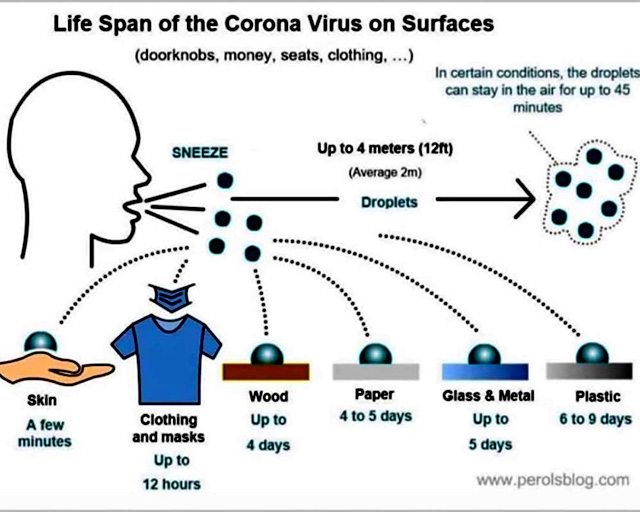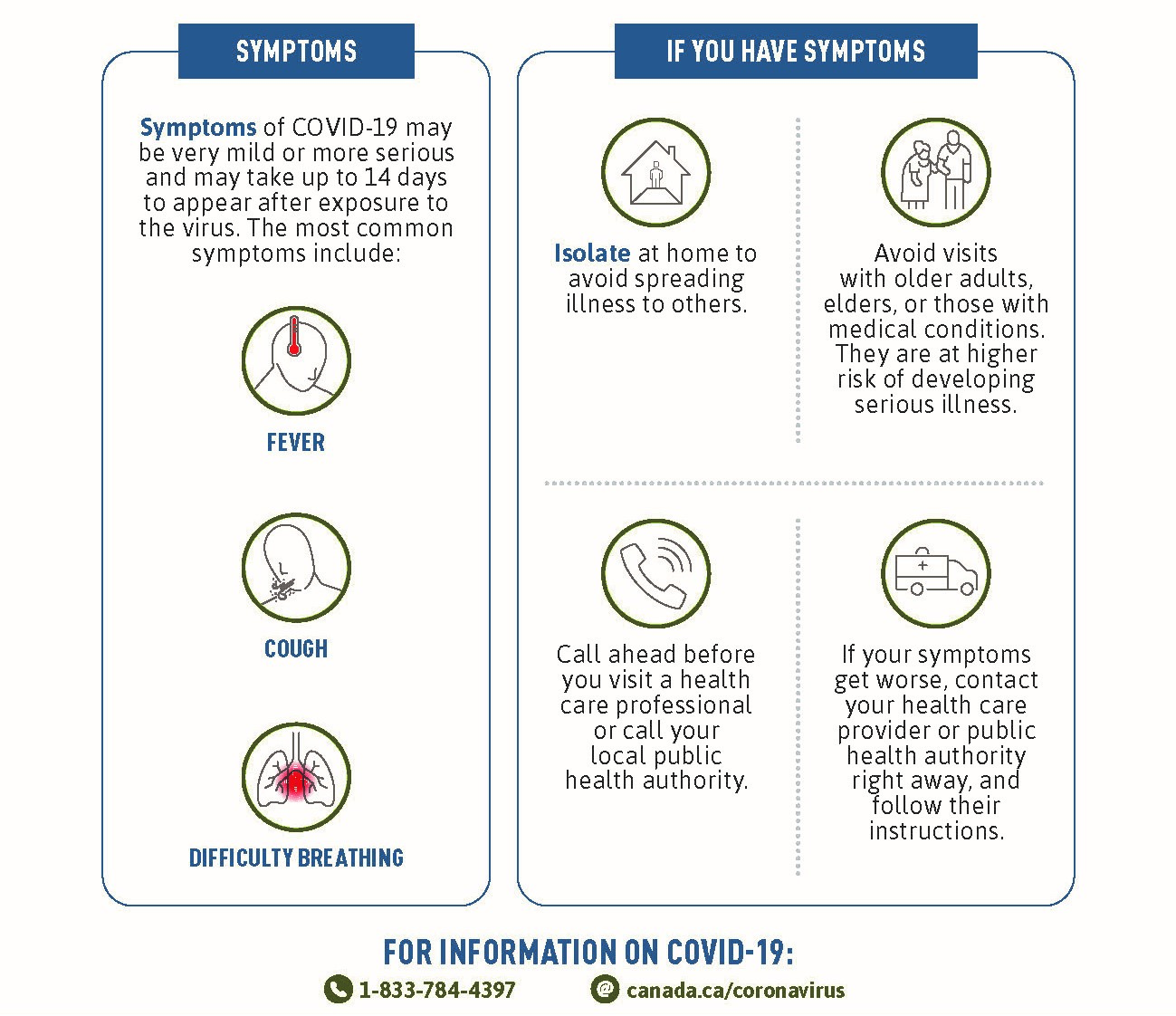Ontario Ministry of Health outlines the symptoms, signs, and clinical features which have been most commonly associated with COVID-19. This information is current as of September 21, 2020 and may be updated as the situation on COVID-19 continues to evolve. If there is a discrepancy between this list and other guidance, this list should be considered as the most up to date.
When assessing for the symptoms below the focus should be on evaluating if they are new, worsening, or different from an individual’s baseline health status (usual state). Symptoms should not be chronic or related to other known causes or conditions (see examples below).
Common symptoms of COVID-19 include:
• Fever (temperature of 37.8°C/100.0°F or greater)
• Cough (that is new or worsening (e.g. continuous, more than usual if chronic cough) including croup (barking cough, making a whistling noise when breathing)
o Not related to other known causes or conditions (e.g., chronic obstructive pulmonary disease)
• Shortness of breath (dyspnea, out of breath, unable to breathe deeply, wheeze, that is worse than usual if chronically short of breath)
o Not related to other known causes or conditions (e.g., chronic heart failure, asthma, chronic obstructive pulmonary disease)
Other symptoms of COVID-19 can include:
• Sore throat (painful swallowing or difficulty swallowing)
o Not related to other known causes or conditions (e.g., post nasal drip, gastroesophageal reflux)
• Rhinorrhea (runny nose)
o Not related to other known causes or conditions (e.g., returning inside from the cold, chronic sinusitis unchanged from baseline)
• Nasal congestion (stuffy nose)
o Not related to other known causes or conditions (e.g., seasonal allergies)
• New olfactory or taste disorder (decrease or loss of smell or taste)
o Not related to other known causes or conditions (e.g., nasal polyps, allergies, neurological disorders)
• Nausea and/or vomiting
o Not related to other known causes or conditions (e.g. transient vomiting due to anxiety in children, chronic vestibular dysfunction)
• Diarrhea
o Not related to other known causes or conditions (e.g., Irritable bowel syndrome, inflammatory bowel disease, side effect of medication)
• Abdominal pain that is persistent or ongoing
o Not related to other known causes or conditions (e.g., menstrual cramps, gastroesophageal reflux disease)
Atypical signs and symptoms of COVID-19 should be considered, particularly in infants and children, older persons, and people living with a developmental disability.
Atypical symptoms can include:
• Chills
• Headache that is new and persistent, unusual, unexplained, or long-lasting
o Not related to other known causes or conditions (e.g., tension-type headaches, chronic migraines)
• Conjunctivitis (pink eye)
o Not related to other known causes or conditions (e.g., blepharitis, recurrent styes)
• Fatigue, lethargy, or malaise (general feeling of being unwell, lack of energy, extreme tiredness) that is unusual or unexplained
o Not related to other known causes or conditions (e.g., depression, insomnia, thyroid dysfunction, anemia, malignancy)
• Myalgias (muscle aches and pain) that are unexplained, unusual, or long-lasting
o Not related to other known causes or conditions (e.g., fibromyalgia)
• Decreased or lack of appetite
o For young children and not related to other known causes or conditions (e.g., anxiety, constipation)
Atypical signs should be based on an assessment by a Health Care Provider, should not be explained by other known causes or conditions, and can include:
• New or unusual exacerbation of chronic conditions (e.g. chronic lung diseases such as asthma, emphysema, or chronic obstructive pulmonary disorder)
• Tachycardia (fast heart rate), including age specific tachycardia for children
o Not related to other known causes or conditions (e.g., atrial fibrillation)
• Low blood pressure for age
• Hypoxia (i.e. oxygen saturation less than 92%)
o Not related to other known causes or conditions (e.g., chronic obstructive pulmonary disorder)
• Difficulty feeding in infants
o Not related to other known causes or conditions (e.g., gastroesophageal reflux disease, cleft palate)
• Delirium (acutely altered mental status and inattention)
o Not related to other known causes or conditions (urinary tract infection, substance-related such as alcohol withdrawal, medication induced)
• Increased number of falls in older persons
• Acute functional decline (a sudden change in ability to function compared to baseline)
o Not related to other known causes or conditions (e.g. gradual decline over months due to a neurological disorder such as dementia or Parkinson’s disease)
Clinical features of COVID-19 that can be diagnosed by a health care provider include:
• Clinical or radiological evidence of pneumonia
Multisystem Inflammatory Syndrome in Children and Adolescents (MIS-C) less than 19 years old
Information on this syndrome and its temporal association with COVID-19 is still emerging and may evolve over time. An assessment for MIS-C should be done by a Health Care Provider. Please see the World Health Organization (WHO) Case Definition or the Canadian Paediatric Surveillance Program (CPSP) Case Definition for diagnostic criteria.
The WHO MIS-C preliminary case definition:
• Persistent fever for 3 or more days
AND two or more of the following:
• Rash or bilateral non-purulent conjunctivitis or muco-cutaneous inflammation signs (oral, hands, or feet).
• Hypotension or shock.
• Features of myocardial dysfunction, pericarditis, valvulitis, or coronary abnormalities (including ECHO findings or elevated Troponin/NT-proBNP),
• Evidence of coagulopathy (by prolonged PT, PTT, elevated d-Dimers).
• Acute gastrointestinal symptoms (diarrhea, vomiting, or abdominal pain).
AND
• Elevated markers of inflammation such as ESR, C-reactive protein, or procalcitonin.
AND
• No other obvious microbial cause of inflammation, including bacterial sepsis, staphylococcal or streptococcal shock syndromes.
AND
• Evidence of COVID-19 (RT-PCR, antigen test or serology positive), or likely contact with patients with COVID-19


